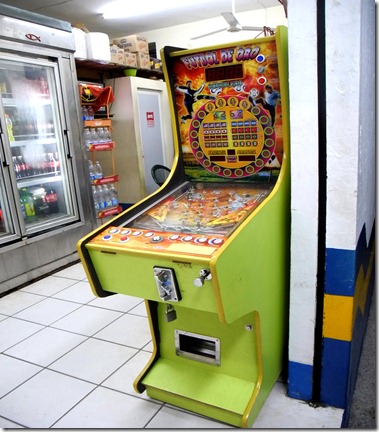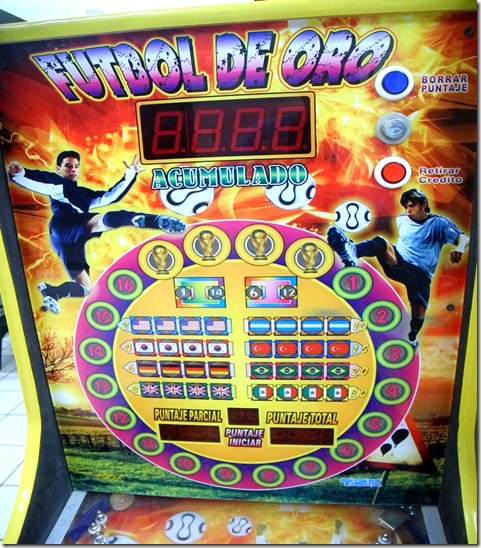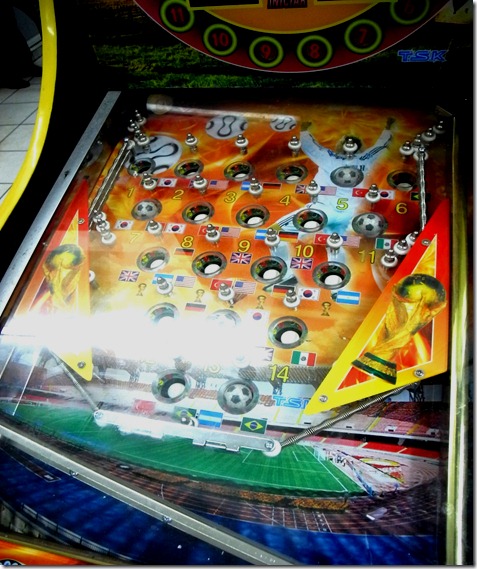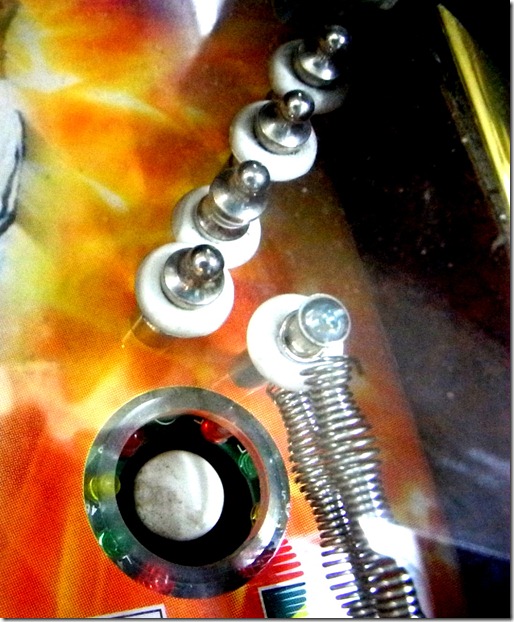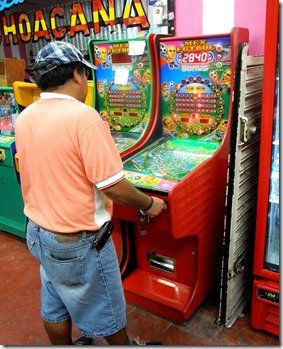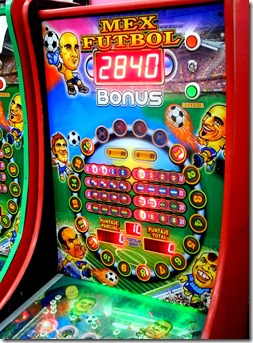Recently (Jan. 2013), I witnessed a teenager playing a pinball machine located inside a small variety store in Mexico. I stopped to watch the young man play, as it brought back memories of the pinball machines that I occasionally played as a teenager in Toronto in the 1950s. I was never very adept at operating these machines, but the seeing one again brought back a few pleasant memories.
Though pinball machines were invented before the turn of the 20th century, they did not become widely played until the early 1930s, when a coin-operated machine was patented. The game of pinball gained further popularity after the Second World War. The “Golden Age of the Pinball” is considered to be between the years 1948 and 1958. The increased popularity was mainly due to the inclusion of “flippers” in the machines, which allowed a player to redirect the ball as it descended on the playing board. Flippers redirected a ball upward or sideways, increasing the skill level of the game. Because some players tried to cheat by shaking the machine to alter the course of the ball, a “tilt” mechanism was added to the machines. If a player shook the machine too much, the game stopped, a “tilt” sign flashed on the headboard, accompanied by a loud ringing noise. I remember that when this happened, everyone watching laughed and shouted “tilt-tilt” at the offending player. I also remember that when I was a child, the frames and legs of the machines were constructed of wood, but by the time I was a teenager, they had been replaced with steel and chrome.
Though many arcades still attracted players during the 1980s and 1990, the popularity of the machines slowly declined. One of the last pinball places in Toronto was the short-lived “Pinball Cafe” in the city’s Parkdale area, which closed in 2012. I am not aware if any remain in Toronto today, since teenagers now are glued to their their computers, Ipods and Ipads, never experiencing the flashing lights and noisy clicking of the glorious pinball machines of yesteryear. In previous decades, pinball arcades were gathering places where people met others and competed in a friendly game. The social interaction they provided is sadly missed, although some parent are likely grateful. I remember that my parents considered Pinball Arcades as places where dubious characters gathered.
When I was a teenager, there were no pinball machines in our neighbourhood in Toronto, but I remember the various Pinball Arcades in the downtown, particularly on Yonge Street. I recall that one of them was on the west side of Yonge, a short distance north of Dundas Street. Its frontage on the street was all glass, and in summer it was completely open to the street to entice people to enter. The interior was brightly lit, noisy, with lights constantly flashing as players wracked up scores that were displayed prominently on the headboards of the machines. The proprietor offered prizes for the highest scores attained on certain games.
A pinball game began when a player inserted a coin into the coin slot. The first shiny silver was released from the top of the board. It rolled down among the pins that directed its path. The ball bounced off the pins, and was redirected by the player using the flippers. When a ball eventually dropped into a hole, depending on which hole it entered, the score was tallied. The ball that had entered a hole was now out of play, and another ball was released. When all the balls (usually three or four) had dropped into holes, the game ended and the final score lit up on the headboard of the machine. It was fascinating game to play, matching your luck and skill against the machine. I thought it was also a great game to watch. During a game, the clicking of the metal balls, the bright flashing lights, and the noisy tallying of the scores were as much a part of the experience as the milkshakes and soda pop that the owner sold to the players.
During the 1950s, no summer resort in Ontario was complete without a pinball arcade. The ones that I remember the most were at the “Lighthouse” at Jackson’s Point, and another at Wasaga Beach on Lake Huron. I believe there was also a Pinball Arcade at the CNE in the 1950s and 1960s.
The headboard of the Pinball Machine that I saw recently in Mexico. It appears to be new, so they are obviously still being manufactured. However, this machine has no “flippers” to redirect the ball, so is based on earlier models. The game is an electronic version of a soccer game and features the game “Futbol de Oro,” (Golden Football). The dark rectangle displaying “8.8.8.8” is where the accumulated score is displayed, hence he Spanish word “acumulado”. I saw a Video Arcade here in Mexico as well, but it possessed no pinball machines, only video games.
The playing board of the game I recently saw, with the holes the balls drop into, and the pins that reflect the balls. The flags of various nation are depicted on the board.
A close-up view of the playing board, with one of the holes (bottom left) and four pins (top centre).
Other pinball machines that I saw in Mexico. They also have no flippers to redirect the ball.
To view the Home Page for this blog : https://tayloronhistory.com/
To view other trips down memory lane in Toronto of old.
Celebrating Victoria Day in Canada in yesteryear
https://tayloronhistory.com/2011/05/22/victoria-day-in-canada/
Old Movie Houses of Toronto
https://tayloronhistory.com/2011/06/27/old-movie-houses-of-toronto/
Memories of the CNE today and in yesteryears
https://tayloronhistory.com/2011/08/22/memories-of-the-cnetoday-and-yesterday/
Listening the the Eaton’s Christmas radio broadcasts of Santa Claus in the 1940s and trimming the Xmas tree
Visiting Toyland on the fifth floor of the old Eaton’s store in the 1940s
https://tayloronhistory.com/2011/11/29/memories-of-eatons-toyland-in-the-1940s/
Remembering the La Chaumiere Restaurant on Church Street in Toronto
Recalling the amber-coloured crinkly bottles of Orange Crush soda pop
https://tayloronhistory.com/2011/12/03/remember-the-amber-crinkly-bottles-of-orange-crush/
Looking back at the restaurant prices in Toronto during the 1950s
The opening of Toronto’s Yonge Street subway in March 1955.
https://tayloronhistory.com/2011/12/03/memorabilia-and-photos-of-the-opening-of-torontos-yonge-street-subway-in-1955/
The classroom Valentine Day boxes in schools in the 1940s and 1950s
/https://tayloronhistory.com/2012/02/14/remember-the-valentine-day-boxes-in-school-classrooms-and-the-heart-shaped-candies/
The old Lux Burlesque Theatre on College Street in the 1960s
https://tayloronhistory.com/2013/01/14/the-bellevue-theatre-lux-burlesque-theatre-on-college-street/
Amazing streetcar trips in Toronto of old
Celebrating New Year’s Eve in Toronto today as compared to yesteryears
https://tayloronhistory.com/2012/12/29/new-years-eve-in-toronto-2012-compared-to-yesteryears/
Memories of Toronto’s Sunnyside on a sweltering hot summer day
https://tayloronhistory.com/2011/07/21/memories-of-torontos-sunnyside-on-a-sweltering-summer-day/
New Year’s Eve in Toronto in 1945 –the first year after the end of the Second World War
https://tayloronhistory.com/2012/12/28/new-years-eve-in-toronto-1945/
I22 people perish in a disaster on Toronto’s waterfront in 1949: CNE Horticultural Building employed as a morgue
The old Toronto Island ferries of my childhood – The trillium, Bluebell, and Primrose
